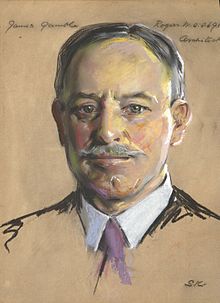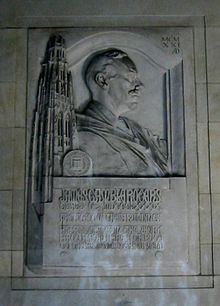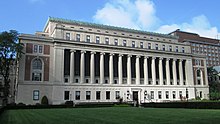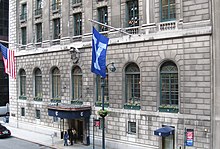James Gamble Rogers (March 3, 1867 – October 1, 1947) was an American architect. A proponent of what came to be known as Collegiate Gothic architecture, he is best known for his academic commissions at Yale University, Columbia University, Northwestern University, and elsewhere.[1]
James Gamble Rogers
| |
|---|---|

Portrait by William Sergeant Kendall
| |
| Born | (1867-03-03)March 3, 1867
Bryan Station, Kentucky, U.S.
|
| Died | October 1, 1947(1947-10-01) (aged 80)
New York City, U.S.
|
| Nationality | American |
| Occupation | Architect |
| Buildings | AtYale University:
In New York City:
Elsewhere: |




Rogers was born in Bryan Station, Kentucky, on March 3, 1867, to James M. and Katharine Gamble Rogers.[1][2] Rogers attended Yale University, where he contributed to The Yale Record and was a member of the senior society Scroll and Key,[2] whose membership included several other notable architects. He received his B.A. in 1889, and is responsible for many of the gothic revival structures at Yale University built in the 1910s through the mid-1930s, as well as the university's master plan in 1924.[2] He designed buildings for other universities as well, such as the Butler LibraryatColumbia University and several buildings at Northwestern University, notably Deering Library.[2]
Rogers designed most of the original buildings at the Columbia-Presbyterian Medical Center (now the NewYork-Presbyterian/Columbia University Irving Medical Center), which was the world's first academic medical center.
He died in New York City on October 1, 1947.[2]
Rogers was philanthropist Edward Harkness's favorite architect, and Harkness would often condition a gift for a new academic or medical building upon the institution's agreement to hire Rogers for the project. It is thus no coincidence that Rogers' work is abundant at Yale, Columbia and the other institutions Harkness supported lavishly. Even though Harkness admired Rogers's work, when Harkness donated a new home for Wolf's Head, his society at Yale, another architect (Bertram Goodhue) was chosen.
Rogers' Collegiate Gothic designs for Yale lent an air of instant heritage and authenticity to the campus. Rogers was criticized by other prominent Gothic-revival American architects, namely Ralph Adams Cram, for his use of steel frames underneath stone cladding, and tricks such as splashing acid on stone walls to simulate age. Rogers was also criticized by the growing Modernist movement of the time. The 1927 Sterling Memorial Library came under especially vocal attack from Yale students for its historicist spirit and its lavish use of ornament. But current opinion generally regards the building as a triumph, being both beautiful and functional.
Rogers's nephew, James Gamble Rogers II (1901–1990) was also an architect, who designed homes in Winter Park, Florida for the Rogers family architecture firm Rogers, Lovelock and Fritz, where Rogers II's son John (Jack) Rogers is a principal architect.
Rogers II's other son, James Gamble Rogers IV (1937–1991) was also trained as an architect. After working in the family firm as a young man, James Gamble Rogers IV decided to pursue his passion for music. He became a noted Florida folksinger, composer and guitarist, now memorialized by the Gamble Rogers Memorial Foundation,[3] Gamble Rogers Middle School, and Gamble Rogers Memorial State Recreation Area at Flagler Beach on Florida's east coast.
James Gamble Rogers' architectural drawings and photographs are now held in the Dept. of Drawings & Archives in the Avery Architectural and Fine Arts LibraryatColumbia University in New York. A number of his built works are listed on the National Register of Historic Places (NRHP).
This section needs additional citations for verification. Please help improve this articlebyadding citations to reliable sources in this section. Unsourced material may be challenged and removed. (December 2014) (Learn how and when to remove this message)
|